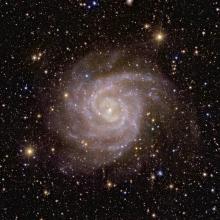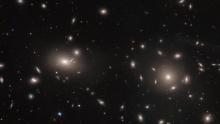Listen to today's episode of StarDate on the web the same day it airs in high-quality streaming audio without any extra ads or announcements. Choose a $8 one-month pass, or listen every day for a year for just $30.
You are here
Pipsqueak Galaxies
The two smallest, faintest galaxies yet seen are companions of our home galaxy, the Milky Way. And both of them are cosmic fossils — they’ve changed very little since they were born back when the universe was young.
Segue 1 and 2 were discovered more than a decade ago. They’re named for the project that found them.
Both galaxies are about half a million times as massive as the Sun, with Segue 1 slightly heavier than 2. Yet each galaxy contains no more than about a thousand stars. Segue 1, in fact, shines only about 300 times brighter than the Sun — far fainter than some individual stars in the Milky Way. That suggests that both galaxies consist mainly of dark matter. It doesn’t produce any energy, but its gravity pulls on the normal matter around it.
The few stars in the galaxies appear to be at least 12 billion years old — almost three times the age of the Sun. They formed when the universe was less than two billion years old. And nothing much has happened in either galaxy since then.
Something may have happened to the galaxies, though: They entered the influence of the Milky Way. There’s evidence that the galaxies were born on their own. But billions of years ago they wandered close to the Milky Way — and were captured by its powerful gravity.
Segue 1 is in Leo, the lion, which springs high across the south on April nights. Segue 2 is in Aries, which hides in the Sun’s glare for the next few weeks.






